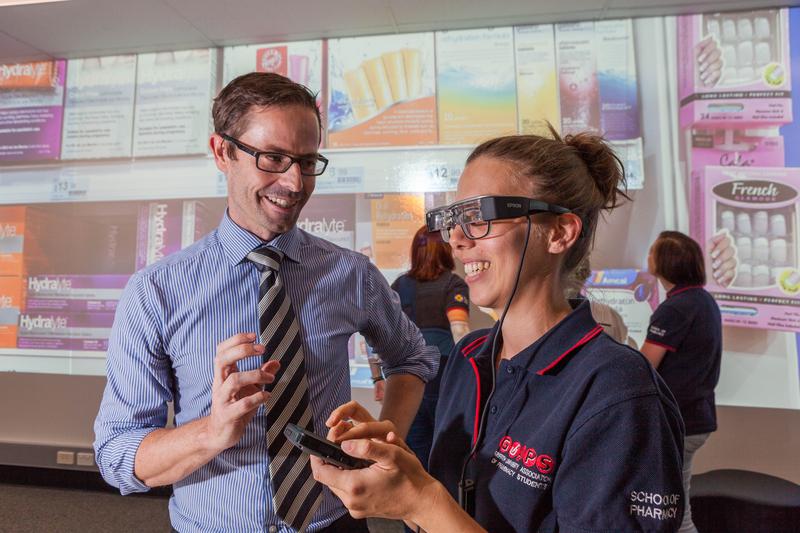
Students at Brisbane-based Griffith University's School of Pharmacy and Toxicology are using wearable augmented reality software - and donning smart glasses - to immerse themselves in modern-day workplace scenarios and get 'life-like' instruction.
Dr Gary Grant, who is deputy head of teaching and learning for the School of Pharmacy, told CIO Australia the smart glass technology exposes students to countless workplaces scenarios, a situation not typically possible under normal teaching environments.
“We’re principally in that mixed reality space. We go from virtual reality to augmented reality to mixed reality. We collect panoramic imagery of the healthcare sector and that includes trying to capture the entire journey of a patient through healthcare in high resolution imagery,” he explained.
“That then is presented to our students as an orientation exercise, and we do that in a couple of modes: in large screen projection, but we also immerse them within that environment using Epson BT-300 smart glasses.”
Epson Australia recently launched the third generation of its Moverio smart glasses for augmented reality. The technology uses silicon-based OLED (organic light emitting diode) digital display technology, which provides transparent mobile augmented reality (AR) experiences, the company said.
At Griffith, Grant said the technology lets students sit inside the treatment room of an emergency department.
“They are looking at that environment, familiarising themselves with the workflow in that environment and the product that exists that relates to the particular discipline of practice. And we really need high resolution imagery to be able to do that. You don’t get the same degree of resolution from other devices.”

Indeed, smart glass technology is becoming more mainstream and key to a wide variety of consumer, commercial and government uses including flying drones, aerial photography and videography, medical surgery, VR learning, AR learning, emergency services response and rescue operations.
Globally, smart glasses are also being used for urban planning, real estate, architecture, engineering, security, media, agriculture management and recreation including gaming, watching movies and AR tours at museums and galleries.
Certainly, the university is no stranger to wearable augmented reality technology Grant said, explaining this isn’t the department’s first foray into smart glass territory. “We’ve been collecting the imagery for three years now,” he said, explaining the university was an early adopter of the BT-200 smart glasses.
“It is just one of those very practical tools to be able to put into the hands of the student without the need for too much familiarisation. But also we're not really worried about the use of those devices because they are not colluded from the environment. They are still engaged with the educator as well as the surroundings that they are in.”
Another application of the technology, he noted, is the use of augmented reality in assisted counseling.
“It is a scenario-driven counselling guides that assist practitioner in counseling patients and that’s more of a research focus and an actual implemented training practice at the moment in our department.”
“We believe to truly train someone in educating a patient on their medicines, you need access to information in all sorts of forms, immediately. Traditionally, you’d be looking at a book, or looking at a computer. But that’s taking your eyes away from the person that’s actually counselling, or being counselled, so in a training setting, we’d allow that person to get a teleprompter-style feed of information to not necessarily give direct instruction, but to guide them through that process.
In a nutshell, he said the technology helps the university standardise care, providing the “training wheels” for practitioners in early practice.
“From an educator’s standpoint, it is exciting. To wait to put students into placement at a later stage is really detrimental to the skillset that a student gains. But it is also logistically very difficult to put someone into practice without skills. So it’s kind of like horses and cart kind of stuff - which one goes first. This technology really lets them build an experience and then skill them up, and then put them back into that experience in a later stage. That’s really exciting for training.”
Asked his next steps, Grant said the university is now shifting to the inclusion of gesture control on the device. It is working with a company called Panedia for its videography needs in the healthcare setting.
“We will still be using the BT-300 but we’re sourcing the addition of gesture control for it. It allows you a more hands-free approach to accessing not only environments, but also in terms of that heads up counselling guide to have a gesture input.”
He said the use of 360 video - rather than the traditional static imagery - is another important push forward. “That would be providing instructor like advice to someone on equipment, or procedures, or practices. It would let you essentially stand on the shoulder of a practitioner and gain insight and skills. It is almost like a first-person point of view experience.”
Grant, a self-confessed gadget guy, said he’s excited about the opportunities associated with these types of emerging technologies.
“I’ve always been a gadget person. I love gadgets. But I think the evolution of gadgetry is giving general everyday users the ability to tailor the content for them, and I think this is exciting. In the past, you needed tech guys and programmers and all sorts of stuff to be able to make it all happen - but now we're getting a whole bunch of tools that are almost ready for practitioners to be able to create ideas and deliver those ideas to the point of practice - and that’s an exciting time at the moment.”
Join the CIO Australia group on LinkedIn. The group is open to CIOs, IT Directors, COOs, CTOs and senior IT managers.
